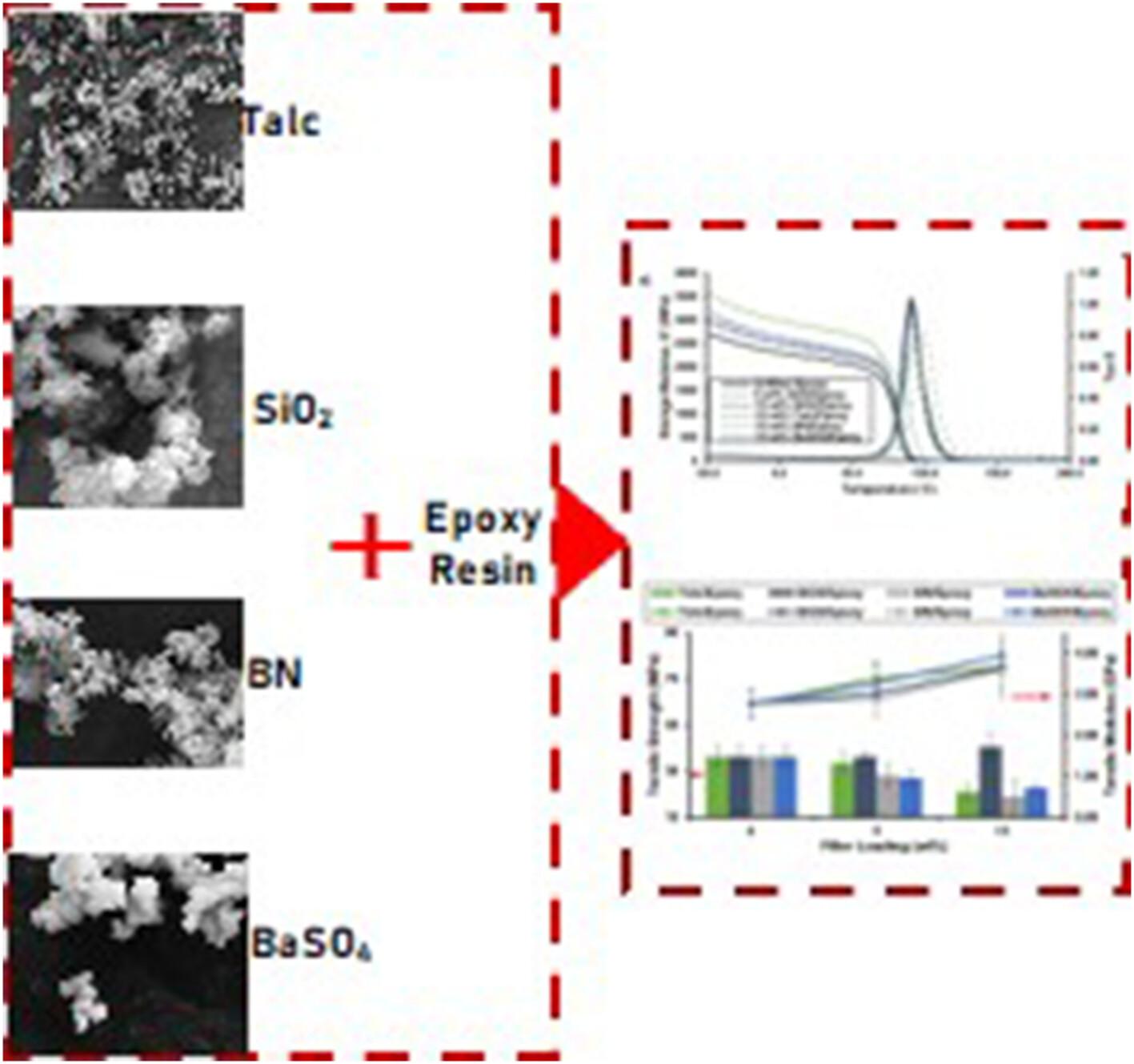William Yung Ling Lim, Mariatti Jaafar, Ku Marsilla Ku Ishak, Karuna Chinniah, Wooi Keong Chan
求助PDF
{"title":"填充了无机微粒填料的环氧树脂复合材料的热机械性能,用于焊接掩模的稳固应用","authors":"William Yung Ling Lim, Mariatti Jaafar, Ku Marsilla Ku Ishak, Karuna Chinniah, Wooi Keong Chan","doi":"10.1002/pi.6648","DOIUrl":null,"url":null,"abstract":"<p>Filler components play a crucial role as thermo-mechanical reinforcement to the epoxy-based solder mask, ensuring effective insulation and passivation. This study investigates the impact of different inorganic filler types (talc, silica (SiO<sub>2</sub>), boron nitride (BN) and barium sulfate (BaSO<sub>4</sub>)) and loadings (5 and 15 wt%) on the tensile and thermal properties of the epoxy composites. The composites were blended, cast and thermally cured. Of these composites, only 15 wt% SiO<sub>2</sub>/epoxy composite exhibits notable increments in both tensile strength and modulus, surpassing unfilled epoxy by 11.65% and 31.9%, respectively. It also displays the highest elongation at break, supported by small particle size, high specific surface area and minimal void volume fraction. For thermal tests, the addition of all fillers increases the storage modulus in both glassy and rubbery regions, especially 15 wt% talc/epoxy composite with 30.09% increment at 25 °C. Additionally, all fillers raise the glass transition temperature (<i>T</i><sub>g</sub>), notably improving it by 9 °C in the 15 wt% BN/epoxy composite. Moreover, their inclusion generally enhances the onset decomposition temperature (<i>T</i><sub>onset</sub>) and reduces weight loss during decomposition. © 2024 Society of Chemical Industry.</p>","PeriodicalId":20404,"journal":{"name":"Polymer International","volume":"73 9","pages":"779-788"},"PeriodicalIF":3.6000,"publicationDate":"2024-05-20","publicationTypes":"Journal Article","fieldsOfStudy":null,"isOpenAccess":false,"openAccessPdf":"","citationCount":"0","resultStr":"{\"title\":\"Thermo-mechanical properties of epoxy composites filled with inorganic particulate fillers for robust solder mask application\",\"authors\":\"William Yung Ling Lim, Mariatti Jaafar, Ku Marsilla Ku Ishak, Karuna Chinniah, Wooi Keong Chan\",\"doi\":\"10.1002/pi.6648\",\"DOIUrl\":null,\"url\":null,\"abstract\":\"<p>Filler components play a crucial role as thermo-mechanical reinforcement to the epoxy-based solder mask, ensuring effective insulation and passivation. This study investigates the impact of different inorganic filler types (talc, silica (SiO<sub>2</sub>), boron nitride (BN) and barium sulfate (BaSO<sub>4</sub>)) and loadings (5 and 15 wt%) on the tensile and thermal properties of the epoxy composites. The composites were blended, cast and thermally cured. Of these composites, only 15 wt% SiO<sub>2</sub>/epoxy composite exhibits notable increments in both tensile strength and modulus, surpassing unfilled epoxy by 11.65% and 31.9%, respectively. It also displays the highest elongation at break, supported by small particle size, high specific surface area and minimal void volume fraction. For thermal tests, the addition of all fillers increases the storage modulus in both glassy and rubbery regions, especially 15 wt% talc/epoxy composite with 30.09% increment at 25 °C. Additionally, all fillers raise the glass transition temperature (<i>T</i><sub>g</sub>), notably improving it by 9 °C in the 15 wt% BN/epoxy composite. Moreover, their inclusion generally enhances the onset decomposition temperature (<i>T</i><sub>onset</sub>) and reduces weight loss during decomposition. © 2024 Society of Chemical Industry.</p>\",\"PeriodicalId\":20404,\"journal\":{\"name\":\"Polymer International\",\"volume\":\"73 9\",\"pages\":\"779-788\"},\"PeriodicalIF\":3.6000,\"publicationDate\":\"2024-05-20\",\"publicationTypes\":\"Journal Article\",\"fieldsOfStudy\":null,\"isOpenAccess\":false,\"openAccessPdf\":\"\",\"citationCount\":\"0\",\"resultStr\":null,\"platform\":\"Semanticscholar\",\"paperid\":null,\"PeriodicalName\":\"Polymer International\",\"FirstCategoryId\":\"92\",\"ListUrlMain\":\"https://scijournals.onlinelibrary.wiley.com/doi/10.1002/pi.6648\",\"RegionNum\":4,\"RegionCategory\":\"化学\",\"ArticlePicture\":[],\"TitleCN\":null,\"AbstractTextCN\":null,\"PMCID\":null,\"EPubDate\":\"\",\"PubModel\":\"\",\"JCR\":\"Q2\",\"JCRName\":\"POLYMER SCIENCE\",\"Score\":null,\"Total\":0}","platform":"Semanticscholar","paperid":null,"PeriodicalName":"Polymer International","FirstCategoryId":"92","ListUrlMain":"https://scijournals.onlinelibrary.wiley.com/doi/10.1002/pi.6648","RegionNum":4,"RegionCategory":"化学","ArticlePicture":[],"TitleCN":null,"AbstractTextCN":null,"PMCID":null,"EPubDate":"","PubModel":"","JCR":"Q2","JCRName":"POLYMER SCIENCE","Score":null,"Total":0}
引用次数: 0
引用
批量引用



 求助内容:
求助内容: 应助结果提醒方式:
应助结果提醒方式:


